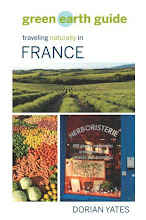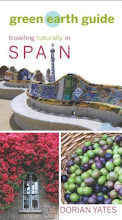



I did London in a brief burst. Decades ago good food was scarce in London, but now it is full of natural foods stores and restaurants, as well as fast-food convenience stores selling decent food for on the go. These chains include EAT and Pret a Manger.
The Fresh and Wild health food stores are beautiful and full of great food. This line of stores was bought a couple of years ago by the U.S. Whole Foods. While the original Fresh and Wild stores remain, Whole Foods renovated an old landmark building, Barkers, on Kensington High Street, and built their flagship store, which puts their U.S. stores to shame. A gigantic store, Whole Foods has 80,000 square feet of natural and organic foods taking up three floors. It offers a variety of over seven different food court options, and sells fair trade and organic clothing, bed linens and gifts. The food part of the store is divided into regular groceries, plus gourmet sections for cheese, wine and other delicacies. They also offer health therapies including massage. The store is easily accessible by Tube – just a block from the High Street Kensington stop, and they also offer delivery services using their groovy-fueled motorbikes.
Whole Foods, Barkers Building, 63-97 Kensington High St, London; www.wholefoodsmarket.com/uk/ ; Open Monday-Saturday: 8am -10pm, and Sundays 12-6. The four former Fresh and Wild store locations can be found at the Whole Foods website.
For travelers feeling desperate for natural food in the Piccadilly Circus area, take heart – a Fresh and Wild is hidden on Brewer Street just behind the north side of Piccadilly Circus with prepared foods and gluten free options.
The Queen’s walk on the south side of the Thames is a great strolling promenade – very busy on nice weekend days. Both the National Theater and Shakespeare’s Globe are along this route, as well as numerous shops and sites. Under Waterloo Bridge you will find a used book market full of old and new titles for reasonable prices open daily. Street musicians are plentiful and talented along this promenade.
A note on London Theater – while the regular, Broadway-like theater productions are expensive, you can find excellent theater for great prices at the National and Globe theaters. The Globe only has productions in the warmer months since they are an outdoor venue, but the National goes year-round. I bought standing room tickets for 5£ each (about $10/ticket) for a wonderful production of George Bernard Shaw’s Major Barbara.
Bus stops and subway stations (the Tube) are everywhere, so between public transport and walking you can get around just fine - in fact a car would be a hindrance in London – the traffic is horrid, parking scarce to none and there is now a fairly hefty congestion-fee for driving in central London. Harry Potter fans will understand when I say that London bus drivers perform very closely to the night-bus drivers portrayed in the books. That said, it is great fun to travel on the double-decker buses and the views from the upper deck are excellent. Check out the day-pass for public transport – good value and so much easier than having to buy tickets each time you hop on a bus or train. French and London bus drivers may go to the same training school. A helpful bookstore employee told me that the Tube employees are trained to be knowledgeable about London and be able to answer questions, but not the bus drivers – she said not to bother to ask them anything. That was a good heads-up, but little did I realize that I would be barked at! One cranky London bus driver called me a “stupid cow” as I was trying unsuccessfully to exit the rear door of the bus (now the French were not helpful, but they did not sling insults).
One word of advice – leave enough time to travel throughout the city. The Tube maps can be deceptive as to how long it takes to travel between stops, especially when venturing out to areas beyond the heart of the city.
For possibly the cheapest prices in London you can explore the Queen’s Market on Saturday mornings by the Upton Park Tube station (takes about 40 minutes from central London). This is in the West Ham area of East London, a block from the West Ham football (soccer) stadium. It offers a good view of the non-tourist side of London – the streets are litter-strewn, and the items at the market vary from foods to electronics to a variety of clothing including saris and shimmering dresses.
London is an awesome city. The exchange rate makes it very expensive (about $2 per 1£ – so double the price of everything- ouch!) The Earl’s Court Hostel is a great accommodation located in the fairly swank South Kensington residential area. It is part of the Hostelling International Network. Prices are exceptional for the middle of London and the hostel is clean, newly renovated, and has internet access for a fee on their computers and wifi throughout if you have your own computer. London Earl’s Court Hostel, 38 Bolton Gardens, Tel: 44 207 3737083; earlscourt@yha.org.uk; www.yha.org.uk. Prices starting at 22£/night per person.
There are countless eating options in London – even the late night convenience stores sell organic foods. I was able to get organic cheeses and bread, as well as wheat-free options and organic ice cream for a friend. So while expensive, London is a great city for traveling green and naturally.























